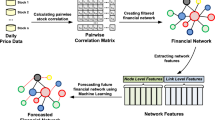Abstract
This paper develops a portfolio optimization model that uses the first three moments of the distribution of the rate of return on investment in selecting portfolios. An alternative measure of skewness is designed for the purpose, and, in the grand scheme of compact factorization, the proposed model is transformed to an equivalent quadratic program with a quadratic constraint with 2 T nonlinear variables and terms, where usually T⩽50. Extensive computational results are obtained on a real-world dataset of the returns of about 3500 stocks that were traded in the NYSE from 3 January to 17 September 2002. In summary, the portfolios built by the proposed model gave the average return on investment of 66.85% over the course of 150 trading days, a period in time when US economy and stock markets suffered tremendously after the tragic events of September 2001.











Similar content being viewed by others
References
Aggarwal R, Rao RP and Hiraki T (1989). Skewness and kurtosis in Japanese equity returns: empirical evidence. The J Financial Res 12: 253–260.
Avriel M, Diewert WE, Schaible S and Zang I (1988). Generalized Concavity. Plenum Press: New York.
Feiring BR, Wong W, Poon M and Chan YC (1994). Portfolio selection in downside risk optimization approach: application to the Hong Kong stock market. Int J Syst Sci 25: 1921–1929.
Ghasemzadeh F, Archer N and Iyogun P (1999). A zero-one model for project portfolio selection and scheduling. J Opl Res Soc 50: 745–755.
Konno H, Shirakawa H and Yamazaki H (1993). A mean-absolute deviation-skewness portfolio optimization model. Ann Opns Res 45: 205–220.
Konno H and Suzuki K-I (1992). A fast algorithm for solving large scale mean-variance models by compact factorization of covariance matrices. J Opns Res Soc Japan 35: 93–104.
Konno H and Suzuki K-I (1995). A mean-variance-skewness portfolio optimization model. J Opns Res Soc Japan 38: 173–187.
Konno H and Yamazaki H (1991). Mean-absolute deviation portfolio optimization model and its application to Tokyo Stock Market. Mngt Sci 37: 519–531.
Maghrebi N (1992). On skewness preference and persistence hypothesis. Japan Financial Rev 15: 17–35.
Markowitz HM (1952). Portfolio selection. J Finance 7: 77–91.
Markowitz HM (1991). Portfolio Selection, 2nd edn. Blackwell Publishers: Malden, Massachusetts.
Markowitz H, Todd P, Xu G and Yamane Y (1993). Computation of mean-semivariance efficient sets by the critical line algorithm. Ann Opns Res 45: 307–317.
Murtagh BA and Saunders MA (1998). MINOS 5.5 User's Guide. Technical Report SOL 83-20R, Systems Optimization Laboratory, Department of Operations Research, Stanford University, Stanford, CA.
Perold AF (1984). Large scale portfolio optimization. Mngt Sci 30: 1143–1160.
Pliska S (1997). Introduction to Mathematical Finance: Discrete Time Models. Blackwell Publishers: Malden, Massachusetts.
Rockafellar R and Wets RJ-B (1991). Scenario and policy aggregation in optimization under uncertainty. Math Opns Res 16: 119–147.
Sharpe W (2000). Portfolio Theory & Capital Markets. McGraw Hill: New York.
Simaan Y (1997). Estimation risk in portfolio selection: the mean variance model versus the mean absolute deviation model. Mngt Sci 43: 1437–1446.
Takehara H (1993). An interior point algorithm for large scale portfolio optimization. Ann Opns Res 45: 373–386.
Tuy H (1995). D.C. optimization: theory, methods, and algorithms. In: Horst R and Pardalos PM (eds). Handbook of Global Optimization. Kluwer Academic Publishers, Dordrecht, The Netherlands, pp 149–216.
Yoshimoto A (1995). The mean-variance approach to portfolio optimization subject to transaction costs. J Opns Res Soc Japan 39: 99–117.
Author information
Authors and Affiliations
Corresponding author
Appendix: Proofs
Appendix: Proofs
Proof of Proposition 1
Consider vectors z1=(z1+, z1−) and z2=(z2+, z2−) with g(z1)⩾g(z2). Then,

Similarly, g(z1)⩽g(z2)⇔s(z1)⩽s(z2).□
Proof of Theorem 1
It suffices to show that

for  is nonconvex.
is nonconvex.
Consider a vector z1=(z1+,z1−) with s(z1)=κ. Note that z1−≠0. W.l.o.g., assume that z1 satisfies z1j+⩾z1,j+1+ for j=1, …, T−1 and that there are l and k (l<k) such that z1l+>z1k+>0.
Consider a vector z2 obtained from z1 by exchanging z1l+ and z1k+ and their counterparts z1l− and z1k− which are equal to 0. Note that s(z2)=κ as well. Now, choose a vector that is a convex combination of z1 and z2, say, z3=(z3+,z3−) ≔ 0.5z1++0.5z2+=(0.5z1++0.5z2+,z1−). We have

In the above, the strict inequality is obtained by the well-known Arithmetic–Geometric Inequality and by the fact that z1l+≠z1k+. This proves that S z is nonconvex and completes the proof.□
Rights and permissions
About this article
Cite this article
Ryoo, H. A compact mean-variance-skewness model for large-scale portfolio optimization and its application to the NYSE market. J Oper Res Soc 58, 505–515 (2007). https://doi.org/10.1057/palgrave.jors.2602168
Received:
Accepted:
Published:
Issue Date:
DOI: https://doi.org/10.1057/palgrave.jors.2602168




